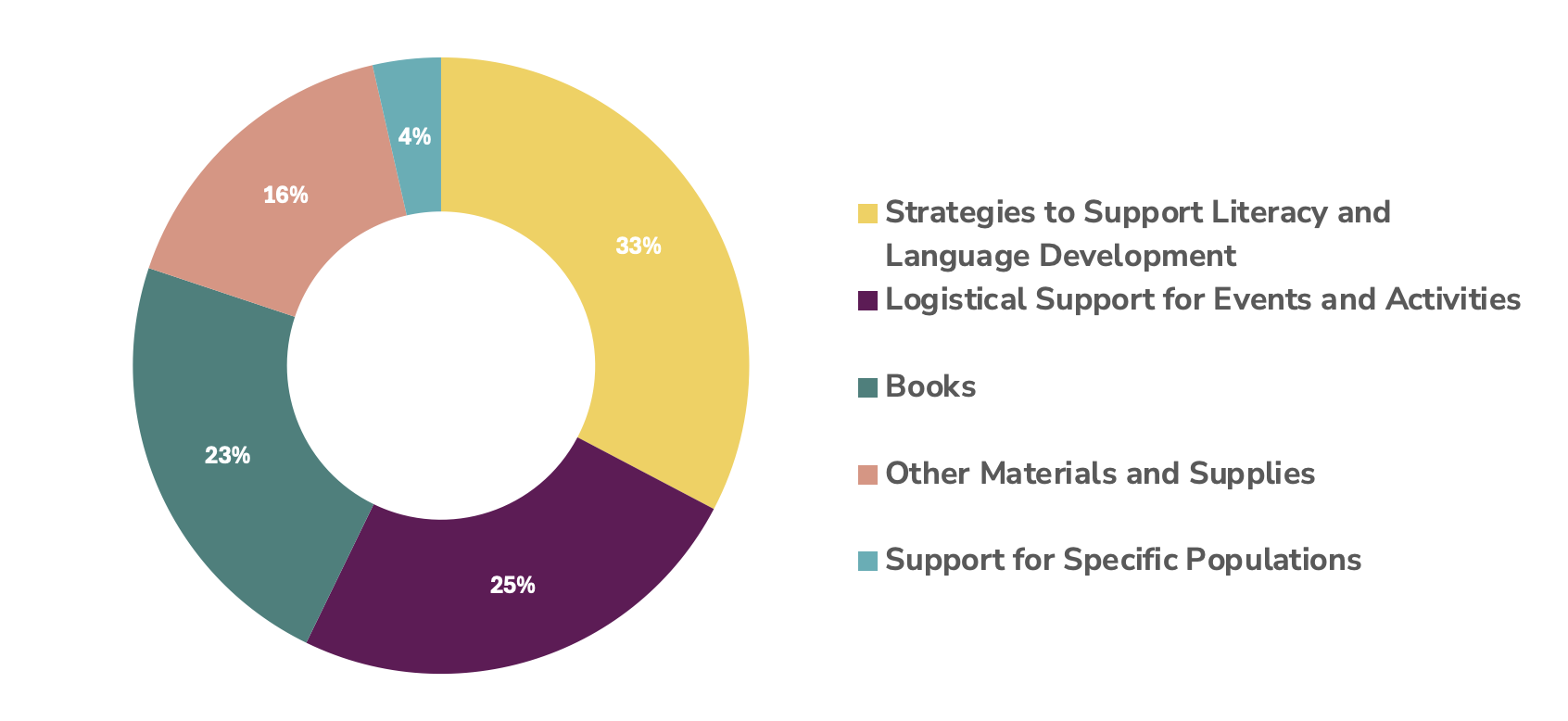Insights from the Neighborhood Literacy Fund: What We’ve Learned About Fighting the Literacy Crisis Through Community-driven Solutions
The best solutions for the community come from within.
That’s the guiding belief behind the Neighborhood Literacy Fund (NLF), a microgrant that supports community-driven solutions to Philadelphia’s early literacy crisis. By awarding up to $2,000, the NLF empowers local residents and grassroots organizations to turn their innovative ideas into action, creating meaningful change for young readers.
When Read by 4th launched this initiative in 2022, we knew it had to be more than just a funding program. To truly support community-led efforts, we designed the NLF using participatory grantmaking and trust-based philanthropy models—two approaches that center the voices and expertise of those closest to the challenges we aim to address. These models not only reflect our values but also draw on nearly a decade of understanding the power of grassroots leadership and community-driven change in Philly’s early literacy ecosystem. Through close partnerships and relationships, we've seen firsthand the incredible work being done on the ground.
We’re proud to announce that to date, the Neighborhood Literacy Fund has awarded $81,040 to support 44 community-driven literacy projects across Philadelphia. But beyond the impact of the grants themselves, we had questions about how the grantmaking process influenced all of the stakeholders involved.
To better understand the impact of the NLF, we partnered with Fors Marsh to evaluate aspects of the model. They took a close look at the applications to uncover what was valued and needed. Additionally, they conducted focus groups to gain deeper insights into the participatory grantmaking process and explore strengths, challenges, and opportunities to enhance its effectiveness.
Read the full report here and explore what we’ve learned so far.
Our Why: Empowering Everyday Community Builders
Those who truly know us understand that The City of Brotherly Love is a well-earned distinction. One of Philadelphia’s greatest strengths is our culture of mutual aid, grassroots leadership, and can-do energy that propels so much of the positive change in this city. On every block, there are grandmas leading quiet revolutions from their stoops, and neighbors organizing to give back. Transformative change–though not always seen–is unfolding at a scale that is truly remarkable.
But even with strong bonds, communities face challenges rooted in inequitable systems. Too many of our neighbors have become accustomed to doing a lot with very little—stretching resources, paying out of pocket, and working unpaid hours just to keep critical community programs alive and help their neighbors. These efforts are heroic and shouldn’t go unrecognized or underfunded.
When we launched the Neighborhood Literacy Fund, we wanted to change that dynamic. We saw the NLF as a chance to honor Philadelphia’s culture of giving while addressing the gaps in the philanthropic system that often leave grassroots efforts behind.
The truth is, traditional grantmaking isn’t always set up to support smaller organizations or individual community leaders with limited resources. Applications are long and complex. Funding requirements are rigid and don’t account for the realities of hyper-local work. And sometimes the size of available grants doesn’t match the needs on the ground.
We knew there had to be a better way—a way to fund solutions that come directly from the people living close to and addressing problems every day. And luckily there have been many incredible thought leaders and practitioners already thinking this way. We looked toward the frameworks of trust-based philanthropy and participatory grantmaking to design the Neighborhood Literacy Fund.
By keeping the application process simple and accessible, we’re removing barriers for those who might not have the time or resources to navigate traditional systems. By shifting who has the power to design the fund and make decisions about who received grants to community members and partners, we are better able to support those who know best what their neighborhoods need. And by providing support at all stages of the application—such as grant writing tips, information on other grant opportunities, and invitations to network with Read by 4th partners—we build a community that extends well beyond a single grant cycle.
The NLF is a small but meaningful step toward building a more equitable funding system—one that values lived experience as much as formal expertise. Because everyone has a role to play in growing stronger readers. And when you give the right tools to the right people, you unlock solutions that go far beyond what any single institution can create.
Neighborhood Literacy Fund awardee and local Reading Captain Bebe Daily speaks with Anne Keenan, the Executive Director of the Philly Book Bank.
We gathered for an evening of celebration, inspiration, and partnership to honor the awardees and supporters of the Neighborhood Literacy Fund.
Benefits of Community in the Selection Process
The NLF Selection Committee brought together a group of passionate Philadelphians who reviewed applications, shared their expertise, and helped decide where funding could have the greatest impact. Committee members—many of whom live and work in the neighborhoods they serve—joined for a variety of reasons.
Some were drawn to the chance to uplift smaller, grassroots organizations:
“Solutions really come from the people, not... fancy, suited-up people.”
Others saw the NLF as an opportunity to “give back” to their communities:
“It felt like an honor. It was really a special process to be a part of.”
And some were excited to learn more about the grantmaking process itself:
“Grant writing is a skill and a privilege that a lot of nonprofits don’t have… This seemed like a very good opportunity for people to still be able to access funds.”
Many also spoke to the inherent value of learning more about the work of others.
“I can't express enough how much I enjoyed the opportunity to be a grant reviewer. I was blown away by the incredible literacy work supporting Philly's children and families.”
This model of participatory grantmaking created a unique space where committee members could deepen their understanding of literacy issues while contributing their own lived experiences to the decision-making process.
The Genius of Community-Led Interventions
One of the most striking takeaways from the evaluation was the creativity and resourcefulness of applicants. These were not cookie-cutter programs but tailored, innovative approaches designed to meet the specific needs of different neighborhoods:
Some projects leveraged culturally responsive practices to connect with families in meaningful ways.
Others used nontraditional literacy methods, like gaming or storytelling in nontraditional spaces.
Several highlighted the importance of youth leadership, with children taking active roles in shaping literacy activities.
As one Selection Committee member put it:
“What it illuminated... was the genius of Philadelphia residents—not traditionally schooled in designing programming but naturally knowing how to connect with their communities.”
Summary of Applicant Requests by Topic
While each applicant brought a unique approach, a common theme also emerged: many requested funding to purchase books. This underscores the value of an ongoing need for accessible children's books. Funding provides community members the power of choice to select books that resonate with their culture, language, and the interests of children in their neighborhoods.












Lightbulb Literacy's Read, Write, Quack! program combined engaging, hands-on literacy lessons with the joy of hatching adorable ducklings. Through duck-themed children's books and interactive activities, children strengthened their reading skills in a fun and memorable way.
“I cannot express how grateful I am to the Neighborhood Literacy Fund for making our library revitalization process a reality.
The Early Literacy Area is most of my young students’ favorite areas in the school, and it would not have been possible without your organization. Our school and neighborhood communities are thrilled at the changes in the library and students cannot wait for the cataloging process to end so they can begin borrowing books to take home.”
Opportunities for Growth
While the NLF has been a powerful tool for sparking community innovation, the evaluation also revealed some areas for improvement:
Collaboration Gaps
Many organizations are tackling similar challenges but working in silos, often due to competition for limited funding. Selection Committee members suggested that Read by 4th could help foster collaboration by connecting applicants with complementary ideas or needs.“It would be amazing to point people together—like, ‘These people would naturally pair well together.’”
Sustainability Challenges
Some applications proposed one-off events that, while valuable, raised questions about long-term impact. Others struggled to envision how $2,000 could sustain broader initiatives.“The consistency to have that space for kids to be exposed to reading multiple times, not just a one-off event, makes a huge difference.”
Support Beyond Grants
Applicants often expressed a need for logistical support, materials, and resources for specific populations, such as students who are blind or deaf. Offering additional capacity-building resources could strengthen the impact of these grassroots efforts.
“What you did by accepting my application was the best thing ever. It was like gold. You listened to what I had to say and gave me an opportunity. I was thinking I couldn’t make a difference and you stood behind me.”
Key Takeaways for Funders and Replicators
The Neighborhood Literacy Fund has shown us what’s possible when you put trust in communities. By prioritizing equity and participation, this model not only funds innovative solutions but also amplifies the voices of those directly affected by the literacy crisis.
If you’re considering replicating this model, here are our top lessons learned to guide you:
Align Funding Capacity with Demand: A challenge we continue to face is high application numbers that lead to high rejection rates. The disconnect between our messaging—"we're here for you"—and the reality of rejecting a substantial portion of applicants underscores the need for clear communication, expectation setting, non-financial support, and an aggressive fundraising strategy to meet demand.
Simplify Access: A straightforward application process removes barriers for smaller organizations and individuals, even those without traditional grant-writing skills. Everyone plays a role in fostering stronger readers. By designing grant applications that meet people where they are, we allow them to focus on the real work, ensuring the greatest impact.
Invest in Relationships: Participatory grantmaking takes time, but the trust it builds with communities is invaluable. By investing in relationships among the selection committee, grantees, and applicants—whether or not they receive funding—we foster a collaborative environment. Sharing resources freely and encouraging connections and collaboration all help build community. Ultimately, investing in people, not only their projects, strengthens our collective mission to protect our children’s right to read.
Whether you are a funder, nonprofit leader, or education advocate, we hope you will join us in continuing to explore all that can be accomplished when we shift power, truly listen to each other, and center community voices.





































